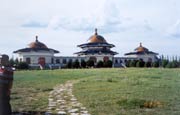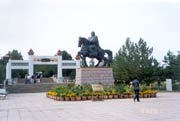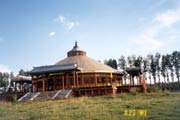|
Yijinhuoluo---the Holy Land of the Mongols
 Yijinhuoluo Grassland sets in the southeast part of the Ordos Plateau. There, little brooks surround green grass, and flocks and herds are leading a happy life. On the grassland, there is a unique and elegant palace, whose brilliance and grandeur can be seen from miles away, and this is the Holy Land of the Mongols----the Mausoleum of Genghis Khan, where the god favored man of the time rests in peace. Yijinhuoluo Grassland sets in the southeast part of the Ordos Plateau. There, little brooks surround green grass, and flocks and herds are leading a happy life. On the grassland, there is a unique and elegant palace, whose brilliance and grandeur can be seen from miles away, and this is the Holy Land of the Mongols----the Mausoleum of Genghis Khan, where the god favored man of the time rests in peace.
The total area of the Mausoleum of Genghis Khan is over 55,000 square kilometers, and the floor space is more than 1500 square kilometers. The palace faces south, and is built on a one-meter-high rectangular base. It can be divided into 6 parts: the front palace, the east palace, the west palace, the palace where the royal couple sleeps, the east corridor and the west corridor. The height of the front palace is 26 meters, with a yurt-like vaulted roof and in the roof, there are also pretty column-shaped decorations and pictures of auspicious clouds inlaid with yellow-and-blue colored glaze. Under the roof, there are double-layered blue aniseed upturned eaves. The east and west palaces are a little lower than the front palace, but the roofs are the same, except that the eaves are single-layered. The three palaces are connected with each other. The stature of Genghis Khan is placed in the front palace, and in the sidewalls of the palace, there are frescos, indicating his great achievements. The back of the palace is directly connected with the palace where the royal couple sleeps, and there are four yurts covered by yellow silk. In the yurt, there are the coffins of Genghis Khan, his wife Boertie, his second wife Hulun, third wife Yixu, his brother Bieligutai, sister Hasaer, his fourth son Tuolei and daughter-in-law Yixihatu. In front of the yurts, there are many precious relics like Genghis Khan's saddle etc. that are handed down through generations.
Genghis Khan is a great and legendary man. There are many stories and records about his death, the place he was buried, his coffin and so on. As is told, when Genghis Khan fought against Western Xia dynasty, he had passed Yijinhuoluo. He stopped his horse, looked around, and was reluctant to leave this beautiful grassland with lush grass, flowers and flocks. Just at that time, the horsewhip dropped from his hand, and he seemed to realize something, and chanted: "a place where flowers and deer inhabits, a home where hoopoes give birth to their babies, a terra where the declined dynasty revives, and a garden where gray-haired man enjoys his life." And he told his servants: "after I died, bury me here." After Genghis Khan was dead, the hearse carrying his corpse was on the way to return to Mongol, but when it came to the place where he had chanted the poem, the cartwheels suddenly sank into the mire, and no matter how many horses drew it, it remained still. Then, people recalled the words that Genghis Khan had said, and built a Mausoleum palace for him just at that place, and called it "Yijinhuoluo"(in Mongol, it means "the holy land of the emperor"). The old Ordos folk song sings like this:
The rich home where the golden deer wander and play,
The happy garden where the hoopoes sing their melody,
The holy place where the emperor was esteemed for generations,
That is Yijinhuoluo, where all pilgrims come to worship.
...
 Legends are mysterious and interesting, but in fact, Genghis Khan was not buried there. According to the custom of the Mongol noble class, "there should be no tomb. Once the corpse is buried, hundreds of horses will trample on it and make it smooth. Then, a camel will be killed on spot and thousands of soldiers will guard it. In the next year, when the grass grows again, all the camps and soldiers will leave the place, and no one will know the exact place of the burial", the real place where Genghis Khan rests has become a secret for ever. However, in order to memorize him, his offspring placed his 8 white camps on the plateau between the Altai Mountain and Kent Mountain, and worshiped them as his mausoleum, and called it "eight white rooms". After the Yuan dynasty, the Mongols offered sacrifices to Genghis Khan every year and all the importance ceremonies were also held in front of the "eight white rooms". In the year Tianshun of Ming dynasty, Ordos (meaning "guard of the palace") tribe began to live in the Hetao Area, and the "eight white rooms" were also moved there. Dayan Khan even sent his third son Baersiboluote as the commander, taking charge of guarding the "eight white rooms". At the beginning of Qing dynasty, the Yikezhao allegiance was set up, and the "eight white rooms" was enshrined near the allegiance. In 1649 (the 6th year of Shunzhi's reign), the prefecture leader of Ordos left wing Zhong Qi, Elinqin became the leader of the allegiance. For the convenience of the meeting each year, he moved the "eight white rooms" to the left wing Zhong Qi, in his own area (today, it is in Yijinhuoluo Qi). From then on, the coffin of Genghis Khan was placed in Yijinhuoluo on the Ordos Plateau, and was guarded and enshrined by the Targuts, which has lasted over 300 years. Legends are mysterious and interesting, but in fact, Genghis Khan was not buried there. According to the custom of the Mongol noble class, "there should be no tomb. Once the corpse is buried, hundreds of horses will trample on it and make it smooth. Then, a camel will be killed on spot and thousands of soldiers will guard it. In the next year, when the grass grows again, all the camps and soldiers will leave the place, and no one will know the exact place of the burial", the real place where Genghis Khan rests has become a secret for ever. However, in order to memorize him, his offspring placed his 8 white camps on the plateau between the Altai Mountain and Kent Mountain, and worshiped them as his mausoleum, and called it "eight white rooms". After the Yuan dynasty, the Mongols offered sacrifices to Genghis Khan every year and all the importance ceremonies were also held in front of the "eight white rooms". In the year Tianshun of Ming dynasty, Ordos (meaning "guard of the palace") tribe began to live in the Hetao Area, and the "eight white rooms" were also moved there. Dayan Khan even sent his third son Baersiboluote as the commander, taking charge of guarding the "eight white rooms". At the beginning of Qing dynasty, the Yikezhao allegiance was set up, and the "eight white rooms" was enshrined near the allegiance. In 1649 (the 6th year of Shunzhi's reign), the prefecture leader of Ordos left wing Zhong Qi, Elinqin became the leader of the allegiance. For the convenience of the meeting each year, he moved the "eight white rooms" to the left wing Zhong Qi, in his own area (today, it is in Yijinhuoluo Qi). From then on, the coffin of Genghis Khan was placed in Yijinhuoluo on the Ordos Plateau, and was guarded and enshrined by the Targuts, which has lasted over 300 years.
 However, in the middle of the 20th century, the Mausoleum of Genghis Khan was moved for several times. In 1939, in order to protect the mausoleum from the war, it has been moved to Xinglong Mountain, in Yuzhong, Gansu province. In 1949, it was moved again to Taer Temple, in Huangzhong, Qinghai province. After PRC was founded, the Central Government of Central Committee of the Party showed great concern to it. In 1954, the Inner Mongolian Autonomous Region formed a delegation to pay a special trip to Taer Temple to welcome the coffin. In April 1, the coffin was moved to Yijinhuoluo. Wulanfu, with functionaries of the Party and government organizations of the autonomous region and thousands of Chinese and Mongols, held a solemn ceremony for it. In order to memorize this great Mongolian hero, the Central Government allocated special funds for the reconstruction of the Cemetery of Genghis Khan. Two years later, in 1956, a new Cemetery full of Mongolian flavor was standing erectly on the Yijinhuoluo Grassland. However, in the middle of the 20th century, the Mausoleum of Genghis Khan was moved for several times. In 1939, in order to protect the mausoleum from the war, it has been moved to Xinglong Mountain, in Yuzhong, Gansu province. In 1949, it was moved again to Taer Temple, in Huangzhong, Qinghai province. After PRC was founded, the Central Government of Central Committee of the Party showed great concern to it. In 1954, the Inner Mongolian Autonomous Region formed a delegation to pay a special trip to Taer Temple to welcome the coffin. In April 1, the coffin was moved to Yijinhuoluo. Wulanfu, with functionaries of the Party and government organizations of the autonomous region and thousands of Chinese and Mongols, held a solemn ceremony for it. In order to memorize this great Mongolian hero, the Central Government allocated special funds for the reconstruction of the Cemetery of Genghis Khan. Two years later, in 1956, a new Cemetery full of Mongolian flavor was standing erectly on the Yijinhuoluo Grassland.
Although because of the Mongolian custom of burial, Genghis Khan's body is not really in the Mausoleum of Genghis Khan today. But during hundreds of years, the Mongols have always taken it as the place where their emperor rests in peace, and paid great respect and yearning for the Mausoleum of Genghis Khan. It is often wreathed by smokes and sacrifice activities never end. Till today, every year, there are four solemn ceremonies on March 21, May 15, August 12 and October 3 in the lunar calendar. On each day of the ceremony, many of the visitors come a long way here devotionally. They stand in front of the great man, present the pure white Hada, the bright candles, the fragrant joss sticks, the tallowy sheep, the yellow ghee, the mellow koumiss and such offerings. They recall his great talent and bold vision, and express their honor.
The Hero Coming to the East----Wobaxi
<<
Gonggeer Grassland---the most beautiful and the nearest to Beijing
>>
|

